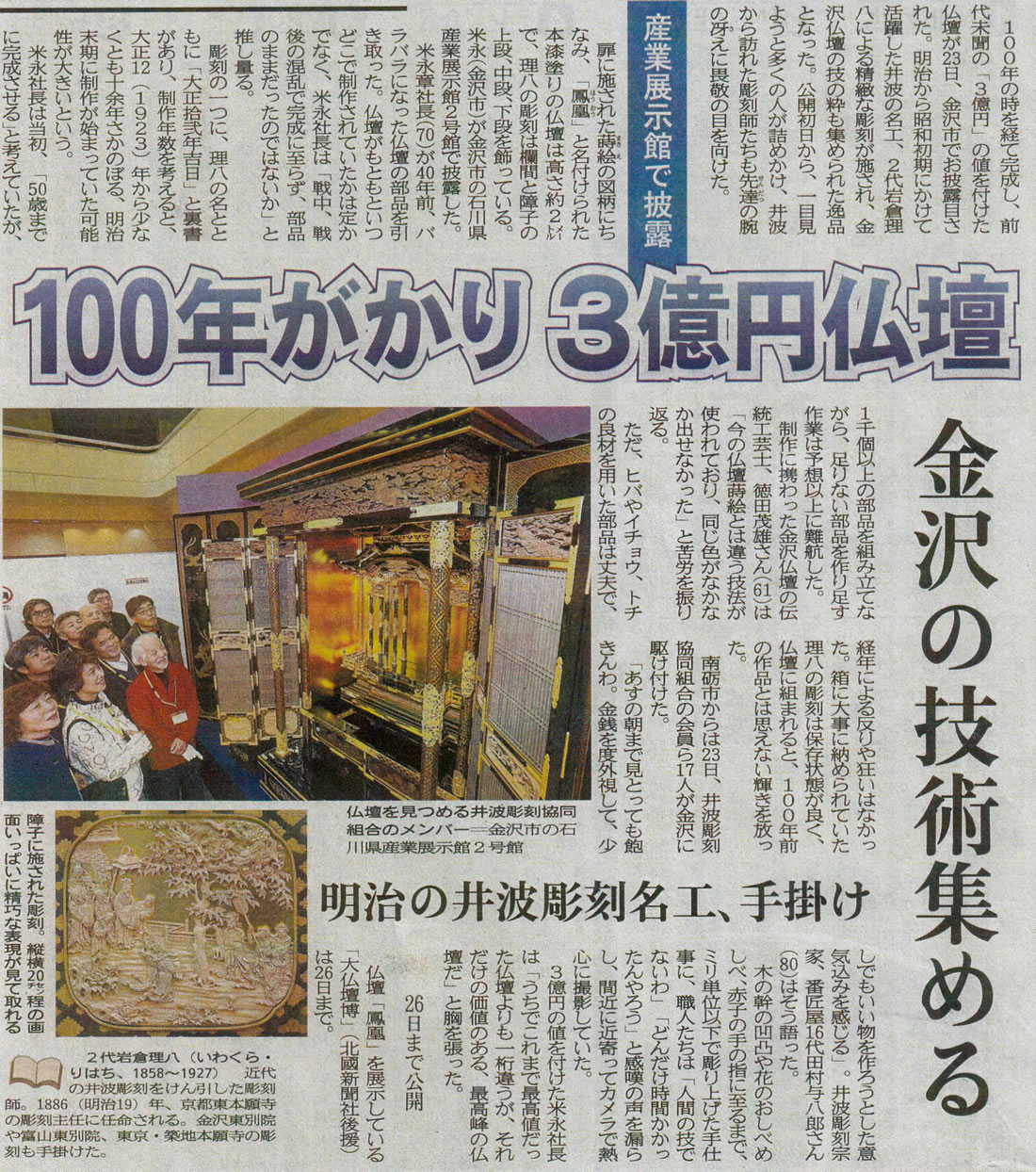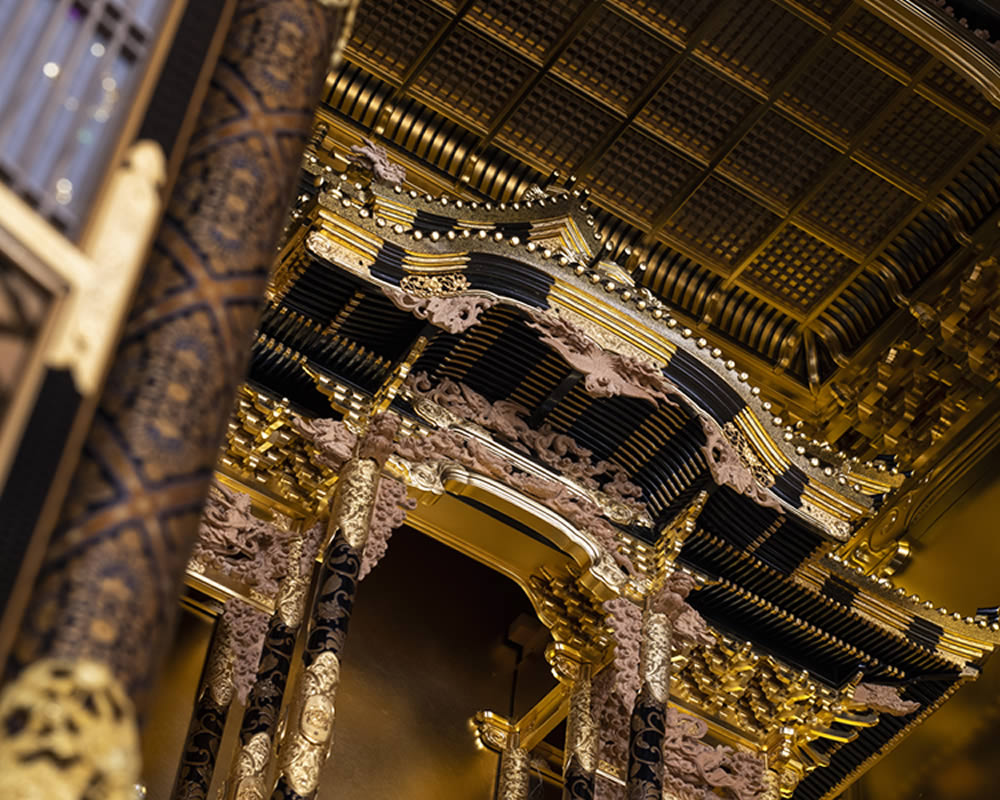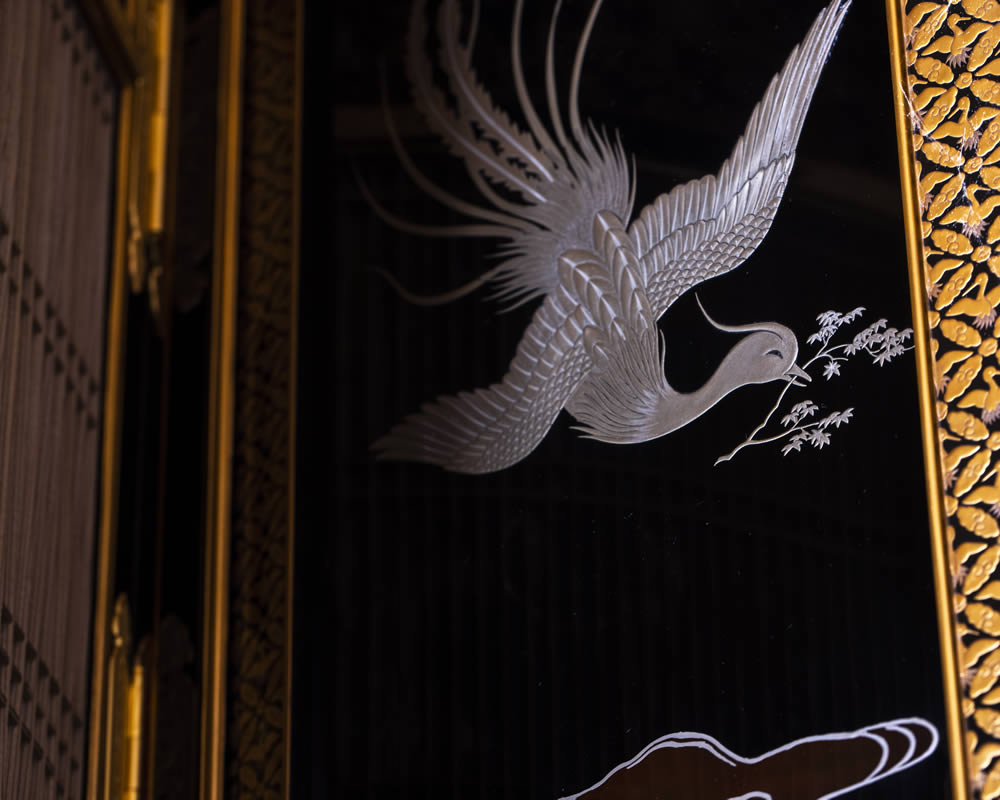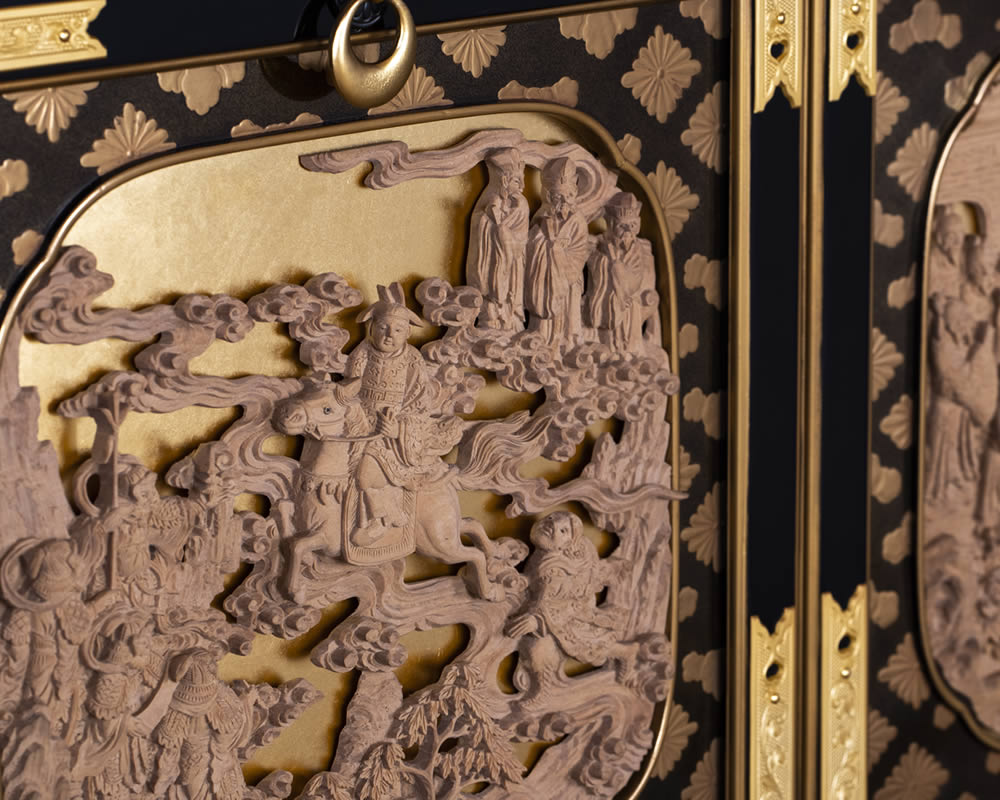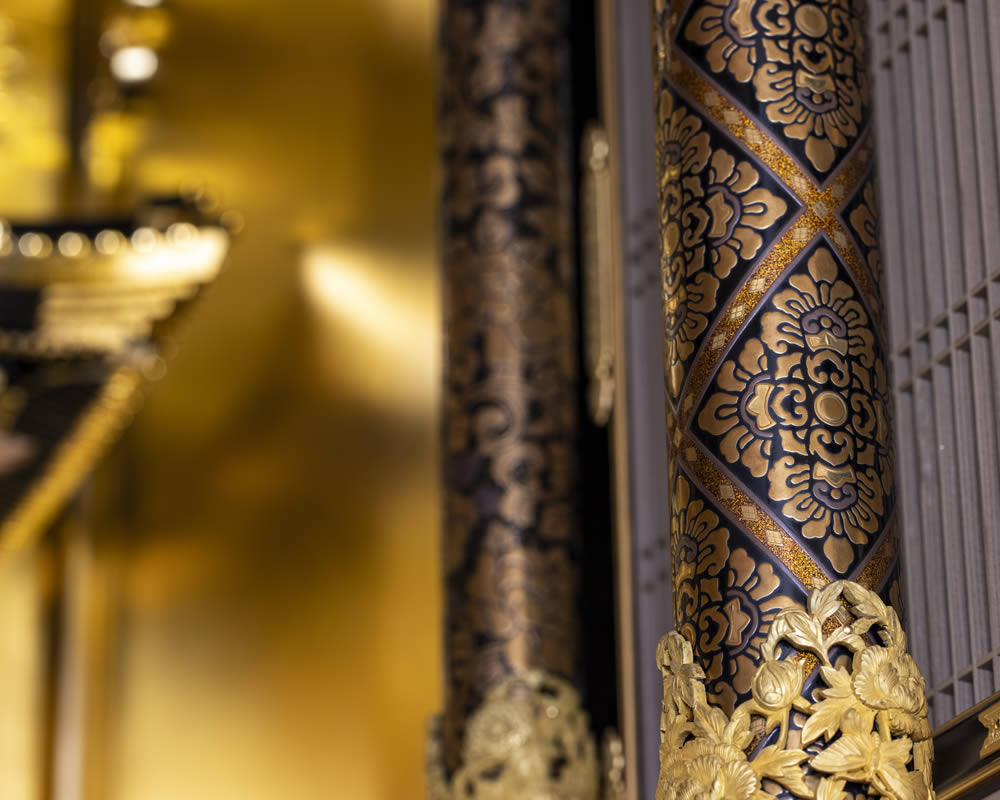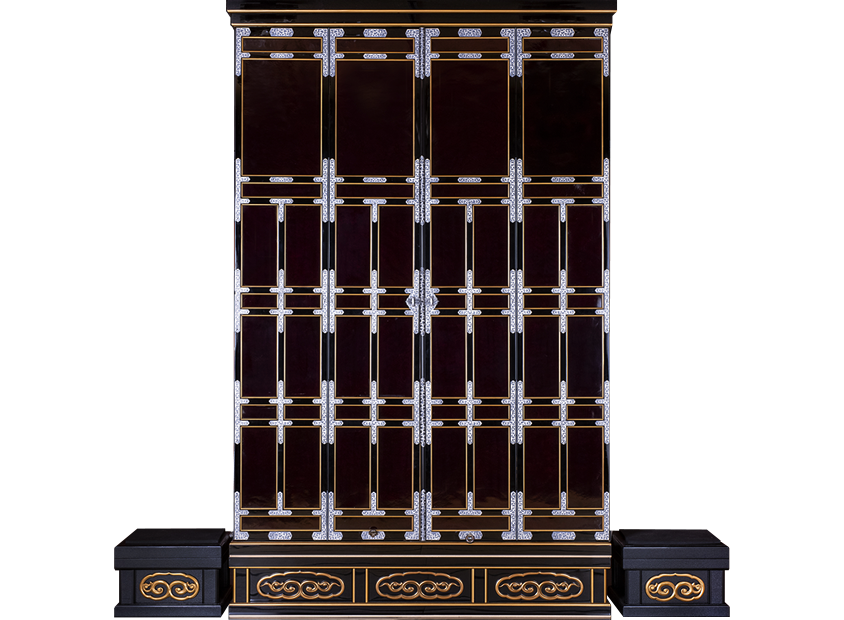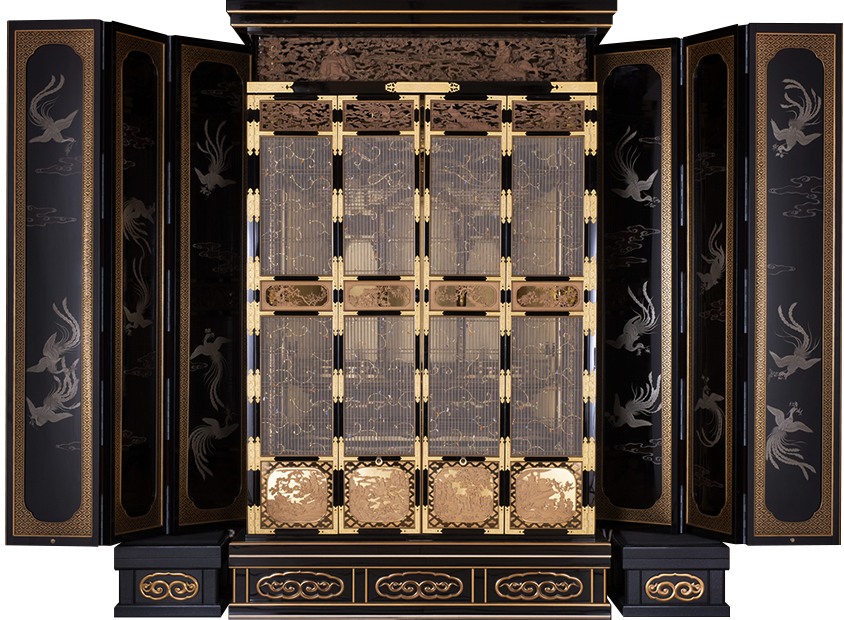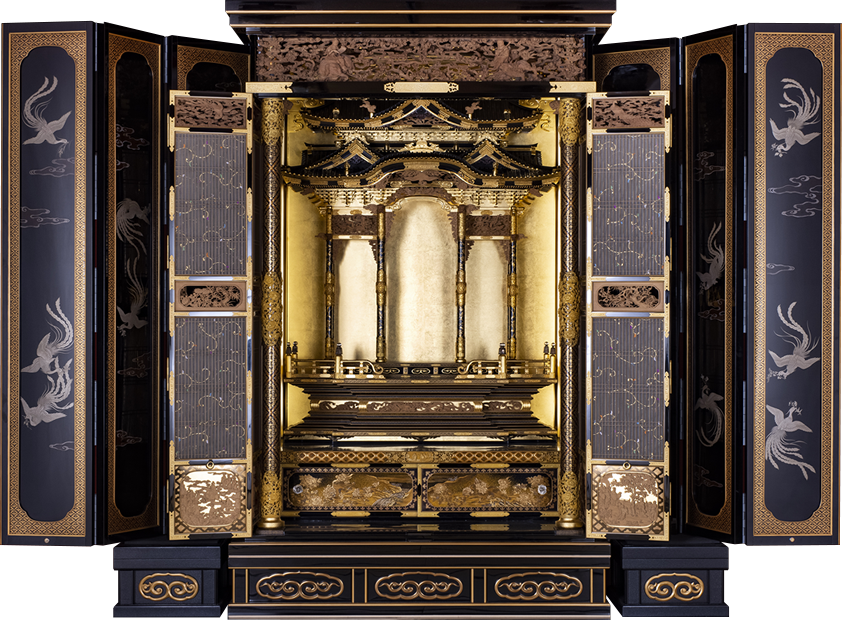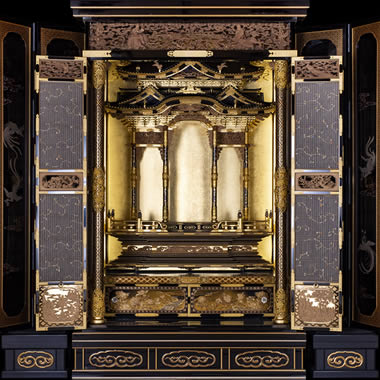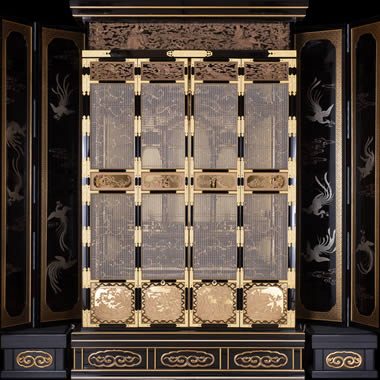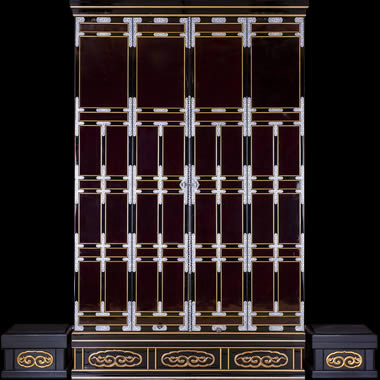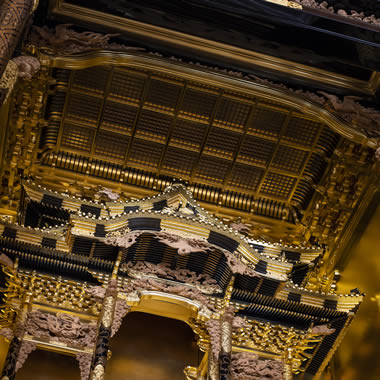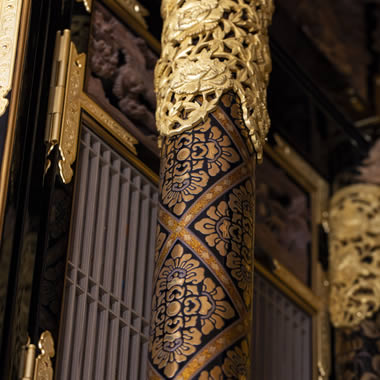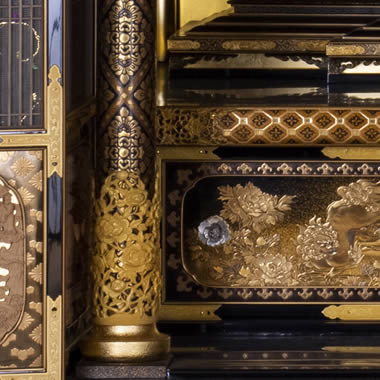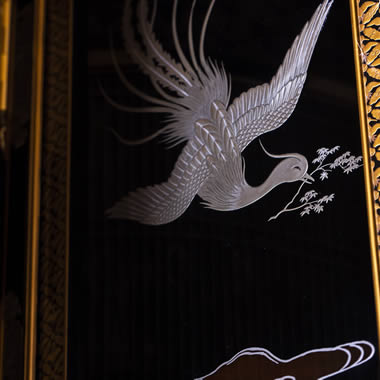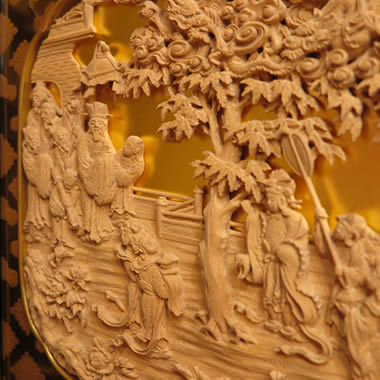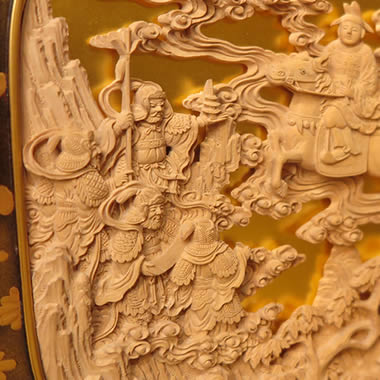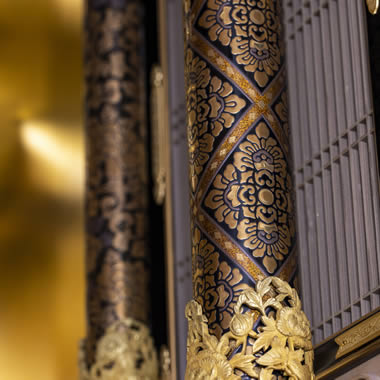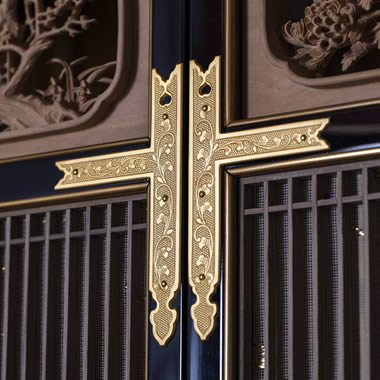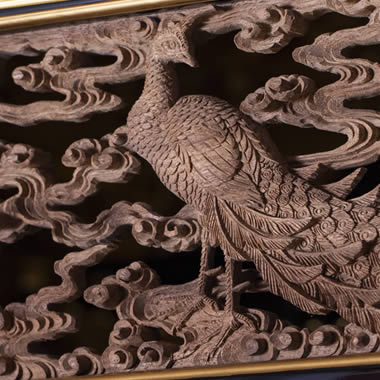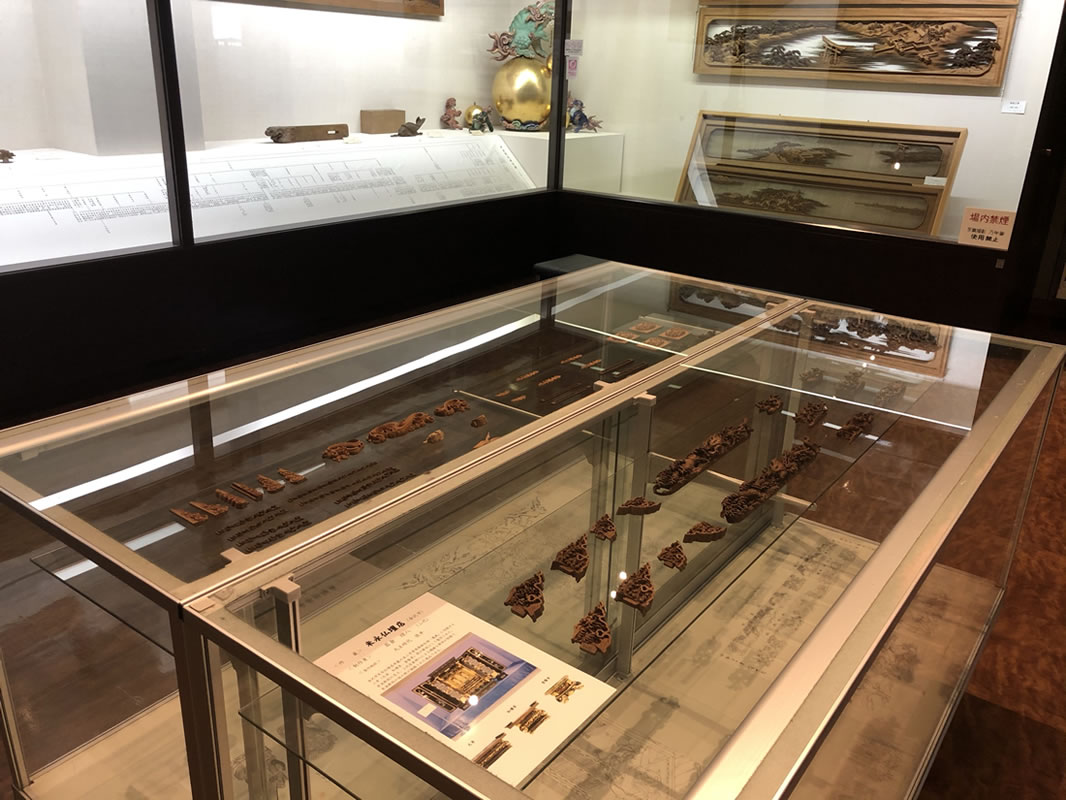


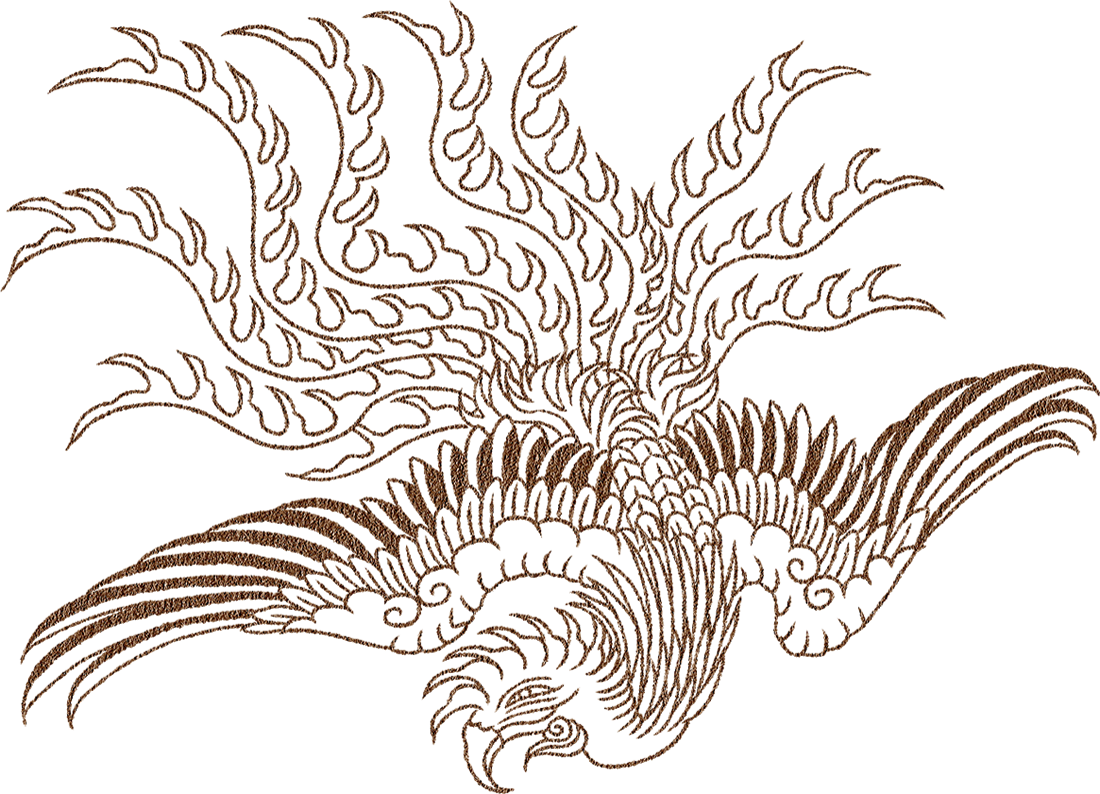

200代
本三方堂造蒔絵仏壇
「鳳凰」
製作を企画してから、ここまでこぎつけるのに100年以上もの年月を費やしてきました。
それは明治から大正末期まで活躍した井波彫刻の名工である二代目岩倉理八氏の木地彫を組み入れていることからも明らかなことです。
それぞれの分野をリードする名工たちの卓越した技術、鑑識眼、長年積み上げた経験を結集することにより、これまでに成し得なかった仏壇がここに誕生しました。
仏壇文化の真髄を、宮殿・木地彫・箔彫・蒔絵・漆塗・金具などの芸術ともいえる職人技をとおしてご覧いただき、ご堪能いただければ幸いです。
200s Honsanhodo
Maki-e Buddhist altar
“HOUOU”
It has taken more than 100 years since I planned the production to get this far. It is clear from the fact that it incorporates the wooden sculpture of the second generation Rihachi Iwakura, a master craftsman of Inami sculpture who was active from the Meiji era to the end of the Taisho era. By combining the outstanding skills, discerning eyes, and many years of experience of the master craftsmen who lead each field, a Buddhist altar that could not be achieved before was born here. We hope that you will enjoy the essence of Buddhist altar culture through craftsmanship that can be said to be art such as palaces, wood carvings, foil carvings, lacquer paintings, lacquer painting, and metal fittings.
「鳳凰」とは
「鳳」は雄鳥を、「凰」は雌鳥を意味し、古くは「朋」と呼ばれました。 360種の羽を持つ動物の長であり、聖天子の治める平和な世にのみ姿を現すとされます。 鳳凰が飛ぶときには、その徳によって雷も嵐もおこらず、河川も溢れず、草木も揺れないという。そして鳳凰が空を飛べば、ほかの鳥もその後をついて飛び、鳳凰が死ねば多くの鳥が嘆き悲しんだといいます。 鳳凰は縁起のよい鳥であることから、多くの美術品や建築物にその意匠が使われており、日本では宇治市の平等院鳳凰堂々京都金閣寺の屋根にあるものが有名です。 こちらの仏壇には蒔絵によって生き生きとした鳳凰がみごとに描かれており、平安をもたらす至福の鳥であることに鑑み、「鳳凰」と命名しました。
What is “HOUOU”?
“鳳” means a rooster, “凰” means a hen, and in ancient times it was called “Tomo”. He is the head of an animal with 360 species of wings, and is said to appear only in the peaceful world governed by the Holy Tenshi. When the phoenix flies, its virtue prevents lightning and storms, rivers from overflowing, and vegetation from shaking. And if the phoenix flies in the sky, the warm bird will follow it, and if the phoenix dies, many birds will mourn. Since the phoenix is an auspicious bird, its design is used in many works of art and buildings. In Japan, the one on the roof of Byodoin Phoenix Hall in Uji City is famous. A lively phoenix is beautifully drawn on this Buddhist altar by lacquer work, and it was named “鳳凰 -HOUOU -(Phoenix)” in consideration of being a blissful bird that brings peace.
「鳳凰」について
| 1 | 木地に使用する材料は耐久性を重視し骨組はヒバ(クサマキ)等、板物は特にイチョウ、トチ等を主体としている。これにより長期の使用が可能。 |
|---|---|
| 2 | 各部分はばぞ組により製作されていることより堅牢である。よってそれぞれ分解し、加工加飾作業が可能であり後日修理洗浄することができる。 |
| 3 | 宮殿自体の高さがあるため、上屋根の上部にいたるまで御堂造りの宮殿の全容がはっきり認められる。宮殿の組物のうち、下屋根の組物は桝を五重に組立て、上屋根の組物は三重に組立て組物地板の穴に差し込んでいる。更に宮殿と須弥壇には本金梨子地蒔きの技法を取り入れており、豪華さを一層引き立てている。 |
| 4 | 塗り加工のうち下地主要部は漆を用いた錆下地であり、中塗りはほとんど全ての部分に施され、上塗りは全て天然漆を使用している。見付板、左右の横板、戸板等は総呂色仕上げとなり、全ての輪類は木地紐を引く。また柱、風呂の戸には切金をふんだんに使用し精巧な技術がみてとれる。 |
| 5 | 技術水準が極めて高い蒔絵を前柱、段縁、中柱、風呂の戸、引出し等に至るまで広範囲にわたって施していることで、蒔絵仏壇としての特色を活かしている。 この蒔絵は総丸粉磨き蒔絵、高蒔絵としているため全体的に渋くかつ上品な美しさを備え、永久的に変色せず拭いても剥げることはない。 特に鳳凰部分け希少なプラチナ粉を使用し、そのデザイン性を高め存在感を際だたせている。 |
| 6 | 彫刻は明治19年に京都本願寺より彫刻主任の命を受けた井波彫刻の名工二代目岩倉理八氏によるものであり、上腰、中腰、下腰及び前指は木肌そのものを眺める一枚板の木地彫となっており、傑作といえる出来栄えである。 現在の金額に換算すること自体が難しく、井波彫刻の大作ともいえる彫刻であり、井波彫刻 協同組合側はその作品を井波彫刻の歴史に残したいとまで言っている。 |
| 7 | 金箔は金沢が全国の主産地であるため、厳選した上質の五毛色金箔を幾重にもはり合わせ使用している。 |
| 8 | 随所に使用される金具は全て総手打金具であり、銀や銅、合金をタガネ、ヤスリ等を用いてつくる伝統的な技法によるもの。よって金具は唯一無二のものである。 |
About “HOUOU”
| 1 | The material used for the wood is durable, and the frame is mainly made of hiba (kusamaki), and the plate is mainly made of ginkgo and horse chestnut. This allows long-term use. |
|---|---|
| 2 | Each part is more robust than it is made by Bazogumi. Therefore, each can be disassembled, processed and decorated, and can be repaired and washed at a later date. |
| 3 | Due to the height of the palace itself, the entire view of the Mido-style palace can be clearly seen up to the upper part of the upper roof. Of the palace braids, the lower roof braid is assembled in five layers, and the upper roof braid is assembled in three layers and inserted into the holes in the base plate of the braid. In addition, the palace and Sumidan have adopted the technique of sowing Honkin Riko, which further enhances the luxury. |
| 4 | Of the coating process, the main part of the base is a rust base using lacquer, the middle coat is applied to almost all parts, and the top coat is all natural lacquer. The veneer, left and right horizontal boards, door boards, etc. are finished in full color, and all the rings are timbered. In addition, the pillars and bath doors are made with plenty of kirikane, and you can see the elaborate technique. |
| 5 | By applying a wide range of lacquer work, which has an extremely high level of technology, to the front pillars, step edges, middle pillars, bath doors, drawers, etc., the characteristics of the lacquer work Buddhist altar are utilized. Since this lacquer work is a total round powder polishing lacquer work and a high lacquer work, it has an overall astringent and elegant beauty, and it does not discolor permanently and does not come off even if wiped. In particular, the phoenix division uses rare platinum powder to enhance its design and emphasize its presence. |
| 6 | The sculpture is by Mr. Rihachi Iwakura, the second generation master craftsman of Inami sculpture, who was ordered by the chief sculptor of Kyoto Honganji Temple in 1897. It is a wooden carving, and it is a masterpiece. It is difficult to convert to the current amount, and it is a sculpture that can be said to be a masterpiece of Inami sculpture, and the Inami Sculpture Cooperative has even said that it wants to leave the work in the history of Inami sculpture. |
| 7 | Since Kanazawa is the main production area of gold leaf in Japan, we use carefully selected high-quality five-haired gold leaf in multiple layers. |
| 8 | The metal fittings used everywhere are all hand-made metal fittings, and are made by the traditional technique of making silver, copper, and alloys using chisel, file, etc. Therefore, the metal fittings are unique. |
200代
本三方堂造蒔絵仏壇
丸粉本金仕上
200s Honsanhodo
Maki-e Buddhist altar,
round powder, genuine gold finish
| ■ 総高 | 200cm |
|---|---|
| ■ 総巾 | 126cm |
| ■ 奥行 | 102cm |
| ■ 漆 | 天然うるし |
| ■ 蒔絵 | 本金粉蒔絵 |
| ■ 木地 | イチョウ、ヒバ、トチ等 |
| ■ Total height | 200cm |
|---|---|
| ■ Total width | 126cm |
| ■ Depth | 102cm |
| ■ Lacquer | Natural Urushi |
| ■ Maki-e | Genuine gold powder lacquer work |
| ■ Kiji | Ginkgo, Hiba, Tochi, etc. |
加賀の仏壇の歴史
加賀の地域で仏壇の製造が繁栄した背景として、次の2つの理由があげられます。
ひとつは、15世紀に来訪した蓮如上人が北陸一円に浄土真宗の教えを広め、庶民の間に非常に根強く息づいてきたこと。
もうひとつは、加賀藩三代藩主前田利常によって整備され、五代藩主綱紀によって完成された細工所によって優秀な工芸芸術家が大勢育ったことです。 当時の細工所は、蒔絵、漆、紙金工、絵、針、具足、薫物、小刀、象眼、刀鍛冶、研物、茜染、大工、御能作物、束帯装束着など、23種にわかれていた模様です。
これらの職人によって作られた製品は諸侯や寺社などの下賜、寄進などに使われ、その美しい金箔平蒔絵、彫刻の技術は一般庶民用の仏壇へと受け継がれていきました。
History of Buddhist altars in Kaga
There are two reasons why the production of Buddhist altars prospered in the Kaga area.
One is that Rennyo Shonin, who visited in the 15th century, spread the teachings of the Jodo Shinshu sect throughout the Hokuriku region and has been very deeply rooted among the common people.
The other is that a large number of excellent craft artists were brought up by the craftsmanship that was maintained by Toshitsune Maeda, the third feudal lord of the Kaga domain, and completed by Toshitsune, the fifth feudal lord.
At that time, the craftsmanship was divided into 23 types, including lacquer, lacquer, paper metalwork, painting, needles, toseigusoku, scents, swords, inlays, swordsmiths, sharpening, madder dyeing, carpenters, Noh crops, and sokutai costumes. It is a pattern.
The products made by these craftsmen were used for gifts and donations of lords and temples, and their beautiful gold leaf lacquer work and sculpture techniques were handed down to the Buddhist altars for the general public.
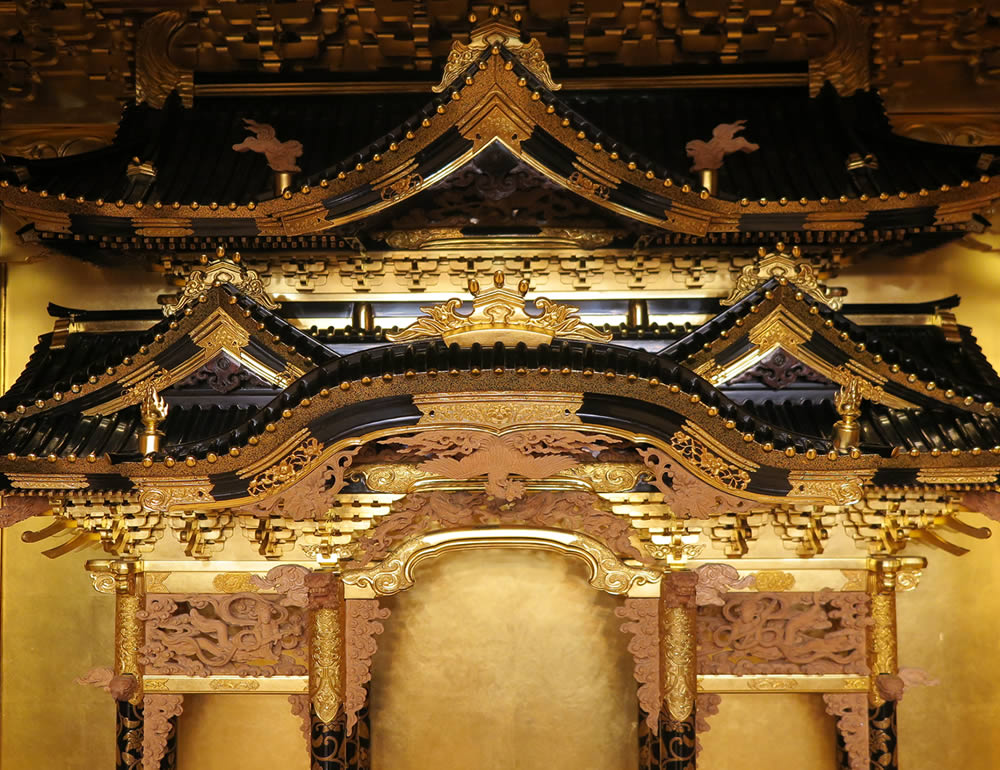
名工・岩倉理八
安政5年(1858年)、井波町生まれ。
井波彫刻の元祖・田村与八郎家の十三代(守貞)に師事して娘婿となり、一時期田村理七を名乗っていたが、後に本家筋の金剛寺屋を継ぐ。
明治19年(1886年)、京都本願寺より彫刻主任に任命される。
昭和2年(1927年)死去。
代表的な功績として、京都の東本願寺、浄土宗総本山知恩院、真宗仏光寺派本山仏光寺をはじめ、井波町瑞泉寺太子堂などの彫刻が認められる。
全国に「井波町木彫」の名を高めた近代井波彫刻の先駆者の一人である。
Master craftsman Rihachi Iwakura
Born in Inami Town in 1858.
He studied under the 13th generation (Morisada) of the Yohachiro Tamura family, the originator of Inami sculpture, and became a son-in-law.
In 1886, he was appointed as the chief sculpture by Kyoto Honganji Temple.
He died in 1927.
His representative achievements include sculptures such as Higashi Honganji Temple in Kyoto, Chion-in Temple, the head temple of the Jodo sect, and Bukkoji Temple, the head temple of the Shin Bukkoji sect.
He is one of the pioneers of modern Inami carving, which has made the name of “Inami-cho wood carving” nationwide.

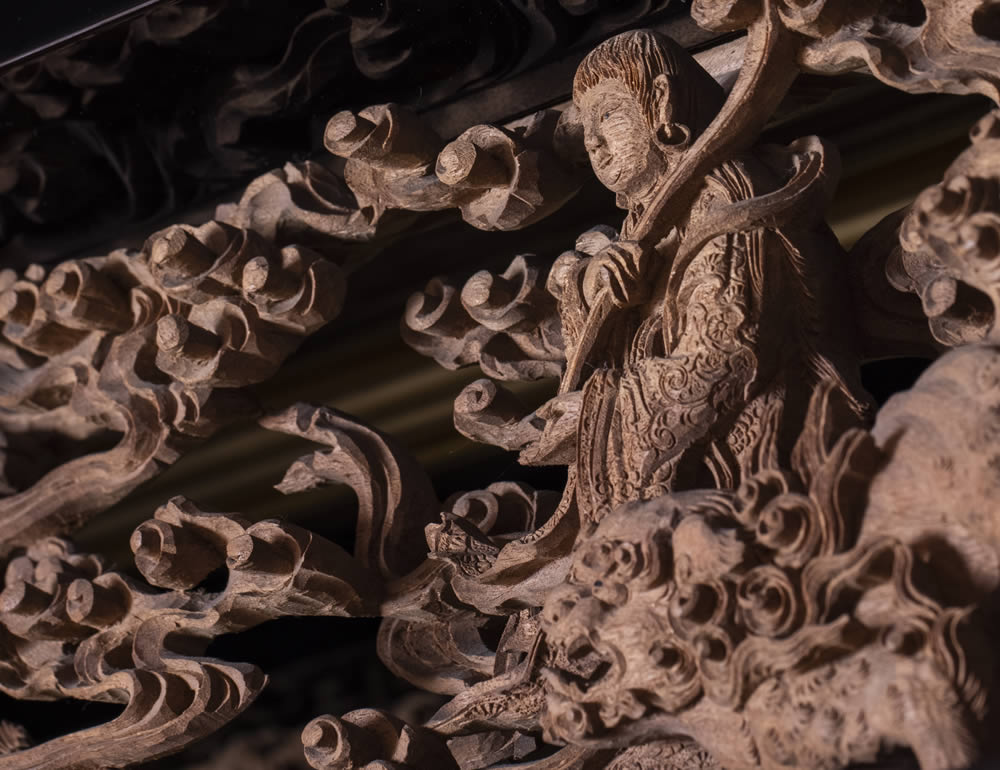
新聞掲載 / 展示Media / Exhibition
